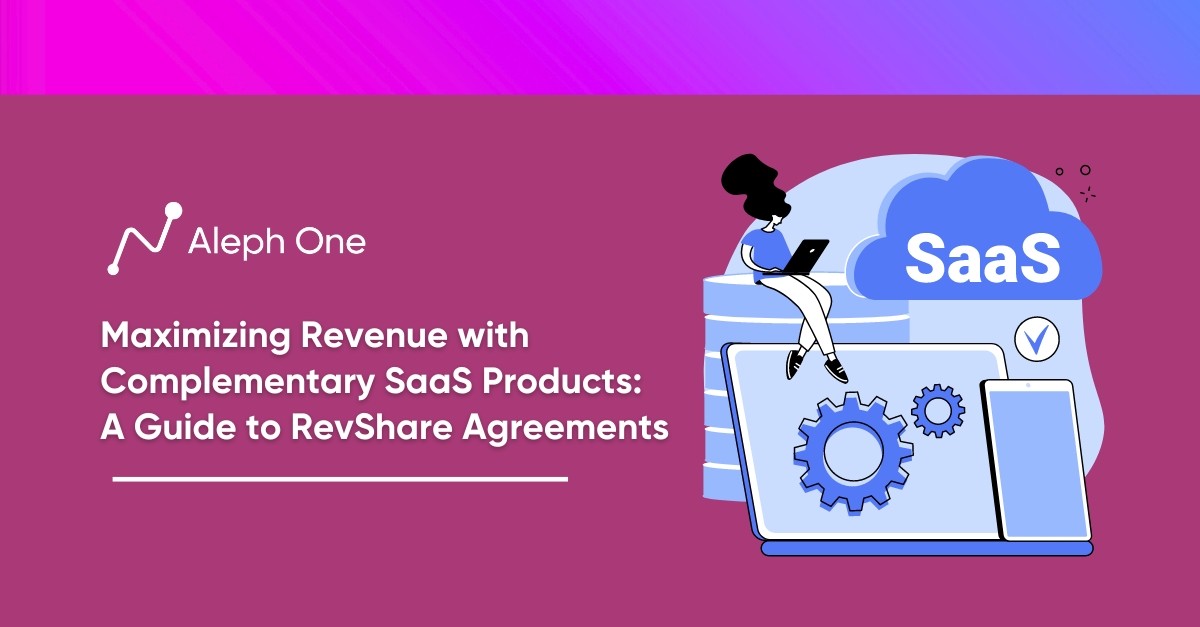Let’s work together to build something amazing. Share your project details and our team will reply to figure out the next steps to your success.

In an era marked by the exponential growth of the software-as-a-service (SaaS) market, a remarkable evolution has taken shape within this landscape: the emergence of Micro SaaS. Defined by its laser-focused solutions tailored to niche business needs, Micro SaaS has swiftly paved the way for startups to establish their presence with lean resources. As these nimble ventures have multiplied, a new avenue for revenue generation and expansion has risen: complementary products and revenue-sharing (revshare) agreements. This guide delves into the strategies and mechanics behind such alliances, illustrating how Micro SaaS companies leverage collaboration to unlock concealed revenue streams and transcend the limitations of solo competition. As the boundaries between solutions continue to blur, this article navigates the evolution of the Micro SaaS ecosystem and forecasts a future where partnership is not just a choice but a pivotal element of success.

The Rise of the Micro SaaS Market
The software-as-a-service (SaaS) market has experienced massive growth over the past decade. According to Gartner, the SaaS market is expected to reach $143.7 billion by 2022, up from $80 billion in 2018. Within this broader market, a new category of SaaS companies has emerge within this broader market: Micro SaaS.
What are Micro SaaS Companies?
Micro SaaS companies build highly-focused cloud solutions for specific business needs. These startups target niche customer segments with specialized tools that are more lightweight, flexible, and affordable than traditional enterprise SaaS offerings. Examples of Micro SaaS companies include Slack, Trello, Dropbox, and MailChimp.
Benefits of the Micro SaaS Model
The Micro SaaS model has enabled new entrepreneurs to launch SaaS businesses with minimal capital investment. Micro SaaS companies can achieve profitability and scale with a small tea by optimizing their products to serve targeted customer needs. This combination of low overhead and highly optimized products has spurred an explosion of new Micro SaaS startups in recent years.
Micro SaaS Companies Growing Year Over Year
According to estimates, Micro SaaS companies have grown over 200% since 2015. These nimble startups now represent a substantial portion of the broader SaaS market. With smaller deal sizes but higher growth rates, Micro SaaS startups have also attracted significant investment from venture capital firms.
Why Micro SaaS Companies are Accelerating
Several technology and market trends have fueled the rise of Micro SaaS. First, the availability of cloud infrastructure from Amazon Web Services, Microsoft Azure, and Google Cloud has made it faster and more affordable to build and launch SaaS applications. Second, the proliferation of SaaS development frameworks and platforms has simplified the process of building cloud-based solutions.
Finally, the growing acceptance of SaaS models across all customer segments, from small businesses to large enterprises, has expanded the addressable market for Micro SaaS companies. With the convergence of these trends, Micro SaaS represents an attractive opportunity for entrepreneurs seeking to build high-growth companies and investors looking to capitalize on the next wave of SaaS innovation.
Why Complementary Products Unlock Hidden Revenue
Micro SaaS companies with complementary products have a crucial advantage: the ability to generate revenue through revshare agreements and strategic partnerships. By working together, complementary solutions can tap into each other’s customer base and benefit from cross-promotion. This “co-opetition” strategy is a win-win, enabling companies to gain new customers and boost revenue without additional marketing costs.
Integrate Solutions and Cross-sell
For example, consider two fictional Micro SaaS companies: ToolA, which provides project management software, and ToolB, which offers team communication and collaboration tools. Each company has a dedicated customer base, but their products solve related business needs. By partnering together, ToolA and ToolB could integrate their solutions and cross-sell to each other’s customers.
Revshare Model
ToolA might offer ToolB’s product to its customers at a discount, earning a percentage of all referred sales. Likewise, ToolB could promote ToolA to its customer base and make a revshare on new subscriptions. Both companies would gain exposure to new potential customers without expensive acquisition costs. This “revshare” model benefits both parties and incentivizes ongoing collaboration.
Product Integrations and Co-marketing
Over time, ToolA and ToolB could deepen their partnership by building product integrations, co-marketing to each other’s mailing lists, and optimizing their solutions to work even more closely together. With a larger combined customer base, they may also have more leverage to negotiate deals with other strategic partners. Partnerships often create a “network effect” that expands growth opportunities.
Revshare agreements represent an innovative strategy for Micro SaaS companies to gain new customers, increase revenue, and build a broader ecosystem. While competition will always exist at some level, strategic cooperation enables startups to achieve more together than they ever could apart. By collaborating with complementary solutions, Micro SaaS companies can unlock hidden revenue streams and accelerate growth mutually beneficially. Overall, revshare partnerships are a prime example of how cooperation shapes the future of SaaS.
Structuring a Winning RevShare Agreement
The key to a successful revshare partnership is a mutually beneficial agreement that incentivizes ongoing collaboration. By determining a fair revenue split, payment terms, and partnership details upfront, companies can set the foundation for a long-term relationship.
Revenue Split
A good starting point is establishing a revenue split that fairly compensates both parties. For example, a 50/50 split is a common arrangement if both companies are contributing equally to the partnership. However, the split may be weighted more heavily toward the company that is providing most of the customer reach or doing the bulk of implementation work. The exact percentage will depend on the unique value and contributions of each partner.
Payment Terms
Payment terms are also important to outline clearly. Partners should agree on details like how often payments will be made (e.g. monthly or quarterly), when payments are due (e.g. 15 or 30 days after the close of the period), and how revenue and costs will be tracked to correctly calculate the payments. Transparency around these financial details builds trust in the relationship.
Define Customer Service Responsibilities
Beyond the financial aspects, a revshare agreement should also define customer service responsibilities, product integration details, and joint sales/marketing activities. For example, the agreement may specify which company will handle customer service for shared clients, how the products will be integrated from a technical and UI/UX perspective, and what collaborative marketing initiatives the companies will pursue together, like co-sponsored webinars, content creation, or event appearances.
Set Expectations to Provide Value to Shared Customers
Establishing these partnership details upfront helps set expectations around how the companies will work together to provide value to their shared customers. With a comprehensive revshare agreement that addresses financial, product, service, and marketing elements, Micro SaaS companies can build a successful long-term partnership that drives revenue through collaboration. The revshare agreement becomes a roadmap for how to navigate the relationship and overcome any challenges that arise.
With a fair and well-designed agreement, revshare partnerships between complementary Micro SaaS companies can be a win-win. By incentivizing ongoing cooperation, these agreements pave the way for a mutually beneficial relationship that fuels growth.
Case Studies of RevShare Success
To see revshare partnerships in action, look no further than companies like Intuit and Square. These companies have built an ecosystem that serves their shared customer base by partnering to offer complementary financial solutions.
Intuit and Square
Intuit, the maker of QuickBooks, partnered with Square to integrate their products, enabling small businesses to get paid, manage their money and pay their bills in one place. By joining forces, Intuit and Square could tap into each other’s customer base and provide greater value to their users. This win-win partnership has been highly successful, with over 2 million small businesses using the integrated Square and QuickBooks experience.
Slack and Dropbox
Another example is Slack and Dropbox, which integrated their products to provide a seamless collaboration experience for users. Slack, a popular workplace messaging app, partnered with Dropbox, a leading file-sharing and storage solution, to allow Slack users to share Dropbox files within Slack conversations easily. This integration makes it simple for teams to collaborate without switching between different apps and services.
Partnership Boosted Company Exposure
For Slack and Dropbox, the partnership has boosted both companies by exposing them to new potential customers. Slack users are now more likely to adopt Dropbox, and vice versa. The integration also improves the user experience, increasing customer satisfaction and loyalty. This is a prime example of a revshare agreement that benefits both parties.
When done right, revshare partnerships can be a crucial growth driver for Micro SaaS companies. By collaborating with complementary solutions, companies can tap into new customer segments, boost revenue through cross-promotion, and build a better overall product experience. Using strategic partnerships and revshare agreements, Micro SaaS startups have an opportunity to achieve scale and profitability more quickly than going it alone. The success of companies like Intuit, Square, Slack, and Dropbox proves that the future of Micro SaaS is partnership.
Expand into New Verticals and Segments
Once a solid revshare model is established, Micro SaaS companies can use it as a platform to expand into new customer segments. For example, a company focused on project management software might partner with a CRM provider to offer integrated solutions for sales teams. By leveraging each other’s products and customer bases, the companies can gain entry into a new vertical market.
How to Expand to New Segments
To expand into new segments, companies should:
- Identify complementary products with an established presence in the target market. These potential partners already understand the customer needs and pain points. They can help tailor solutions and messaging to resonate with customers in that vertical.
- Build a customized integration or bundle. Simply promoting each other’s products may not be enough. Developing a seamless integration or packaged offer can give customers in the new segment a solution tailored to their needs. This also strengthens the partnership by requiring ongoing collaboration.
- Cross-sell and upsell together. Once an integration or bundle is launched, the companies should work together to promote it. This includes email marketing to each other’s customer bases, joint webinars, and sales calls. The personal touch of co-selling helps to raise awareness and drive the adoption of the new offer.
- Provide education and support. When entering a new market, education is key. The partners must invest in resources to help customers in that segment understand how the integrated solutions benefit them. They should also ensure support teams are trained to assist customers using the bundled or integrated offer.
- Continue optimizing. Expanding into new segments is an iterative process. The companies must consistently gather feedback from customers and partners to improve the offer. Over time, they can release new features, strengthen the integration, and refine messaging to convert more of the target market.
With a collaborative revshare model in place, Micro SaaS companies have a built-in platform for expansion. By partnering with complementary solutions targeting new segments, companies can gain a foothold in emerging markets and unlock new sources of revenue growth. The key is a hands-on, co-selling approach to build solutions and educate the new customer base. With ongoing optimization, revshare partnerships that span multiple segments can become a key driver of business success.
The Future is Collaborative
Revshare partnerships represent an innovative growth model for the new generation of Micro SaaS companies. By collaborating instead of competing, these startups can achieve scale and profitability more quickly. As more companies build integrations and establish strategic partnerships, the SaaS ecosystem will become increasingly collaborative, enabling previously impossible solutions.
Partner with Complimentary Solutions
Micro SaaS companies have limited resources and customer bases, challenging growth. However, by partnering with complementary solutions, companies can tap into new customer segments without significantly increasing costs. This collaborative model reduces risk for Micro SaaS startups, allowing them to focus on building a great product for their target customers.
Integrate Product Ecosystems
For customers, integrated product ecosystems provide a seamless experience. As revshare partnerships become more common, customers will come to expect their SaaS solutions to work together out of the box. This will pressure companies to develop strategic partnerships and build integrations with complementary providers. Those who fail to collaborate may be left behind.
Power of Partnerships
The major SaaS players have already demonstrated the power of partnership. Companies like Slack, Dropbox, and Zapier have built platforms that enable thousands of integrations with other solutions. By opening their platforms, these companies have achieved exponential growth and now serve as hubs for entire SaaS ecosystems.
Scale with Strategic Partnerships
Following their lead, Micro SaaS companies should pursue partnerships that will help them scale, even with competitors. A good revshare agreement can turn a competitor into an ally, allowing both companies to gain new customers and tap additional revenue streams. This co-opetition strategy, though counterintuitive, may be the best path to success for small startups looking to establish a foothold.
Scale your Startup with Revshare
The lines between SaaS solutions will blur in the coming years as revshare partnerships expand. The Micro SaaS landscape will transform into a web of interconnected products and services, working together to serve customers in new ways. With collaboration at its core, the future of Micro SaaS is a partnership. Competing alone will no longer be enough. The companies that build ecosystems will lead the pack.
FAQ
Why is the Micro SaaS market continuously experiencing a stable growth?
The consistent, stable growth of the Micro SaaS market is due to several converging factors. The rise of versatile cloud infrastructure services such as Amazon Web Services, Microsoft Azure, and Google Cloud has greatly reduced the cost and technical barriers to launching SaaS applications. Secondly, there’s been an increase in the development and utilization of SaaS development frameworks, facilitating easier building of cloud-based solutions. Lastly, the SaaS model’s growing acceptance across all business sectors – from small businesses to large corporations – has expanded the addressable market for Micro SaaS companies.
What exactly are the main benefits of strategic partnerships amongst Micro SaaS companies?
Strategic partnerships benefit Micro SaaS companies primarily because they allow expansion and revenue generation through shared resources and capabilities. Partnerships often enable these companies to access new customer segments, increase their products’ functionality through integration, and generate more value for their existing customer base. These benefits are usually achieved without the need for significant capital investment, as the shared costs of marketing, development, and customer acquisition are typically lower than going solo. Moreover, partnerships incentivize innovation and cooperation, fueling more dynamic and holistic growth.
What are key elements for success when structuring revshare agreements?
The success of structuring revshare agreements primarily relies on the clear definition of responsibilities and benefits for each party involved. This includes determining a fair revenue split, outlining clear payment terms, defining customer service roles and tasks, and laying out the mutual objectives of the partnership. Transparency and clarity form the backbone of these agreements, fostering trust and ensuring seamless collaboration. The ultimate goal should be to create a mutually beneficial relationship that would drive both companies to work towards enhancing product offerings, value delivery, and customer satisfaction.
Get the latest news and updates from Aleph One in your inbox.



